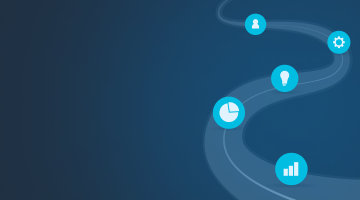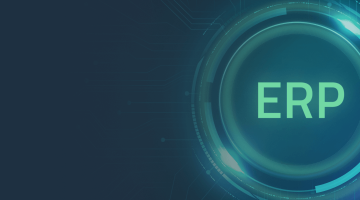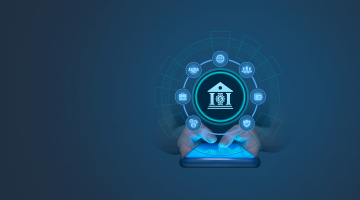

Customer analytics software for banks: Reaching a 360-degree view
Banking has always been a highly competitive industry. The chief reason why it is hard to stand out among your rivals in the field is that the scope of services any financial institution provides to corporate and individual clients is pretty much universal. This list (with minor variations) includes accepting deposits, advancing credits, issuing loans, debit and credit card operations, currency exchange, etc.
The advent of computer technologies and the onset of the global pandemic have created a growing demand for remote financial services, which spells the across-the-board introduction of digital banking instead of conventional brick-and-mortar storefronts. However, a modern fintech solution utilized by a bank isn’t a competitive differentiator anymore but a sine qua non for any financial institution keeping abreast of time.
What can give the bank an edge over its rivals, with everything else being equal? To come up big in the domain, you have to apply customer analytics at an advanced level to understand the needs and divine the expectations of your target audience. In the early third millennium, when digitalization reigns supreme such evaluative and prognosticating techniques come in the form of data analytics software.
Related article:
Top 5 technology challenges for retail banks
Customer data analytics: A closer view
Today, product-oriented policies practiced by many banks for decades prove outdated and require major overhauling. To stay afloat and thrive in the contemporary competitive environment, banks have to switch to a client-centered approach. It means making important business decisions and building strategies with a view to customers’ backgrounds, behavior, and preferences.
To reach this overarching goal, financial organizations leverage customer profile software that is called to give them a 360-degree view of the client. This first stage of client analytics is typically known as business intelligence (BI), when you identify the target clientele and obtain all possible information from external and internal data sources (purchases, registrations, loyalty memberships, surveys, subscriptions, etc.) pertinent to potential or current customers.
Yet, just possessing the data won’t help you much unless you can slice and dice it properly. It is here that customer analytics tools step in, segmenting customers and furnishing valuable foresight as to what should be done to cater to their shifting needs.
Top challenges customer analytics software for banks addresses

Having considerable experience in the sphere, we at DICEUS know that, although it is honed primarily to enhance banks’ awareness of their clients, customer information software can be used to deal with a plethora of related issues as well.
Customer data handling
This is what customer data software is mainly for. Having a comprehensive picture of the clients and their interaction with the bank, its experts can significantly streamline or even automate detecting symptomatic trends, accurately forecast the customers’ future behavior, and map out the bank’s promotion campaigns or other business moves correspondingly.
Customer segmentation
Once you segment your clientele into groups according to various principles (from behavior to the level of income), you will be able to provide better service aimed at those clusters. An important criterion for this parcellation is customer lifetime value – an index that estimates the expected profit the organization will receive during the entire time of cooperation with a particular client. Being aware of it, you will be able to shape your long-term strategy aimed at maximizing the profitability of lasting relations with every client within the group.
Personalization of services
Customer analytics solutions allow banks to zoom in on every client within the group determined by segmentation, unleashing personalized marketing techniques and algorithms, for instance, individualized offers that suit a particular customer to a tee.
Extensive automation of interaction with customers
Any bank striving to hit it big can’t ignore the slightest opportunity to establish rapport with potential customers and maintain it with the current ones. But exercising communication via social media, email, messengers, mobile phones is rather time- and effort-consuming. Respective software that gives access to chatbots and all kinds of electronic assistants enables organizations to automate the lion’s share of these communication endeavors and free personnel to pursue more creative activities where AI falls short (so far).
Customer feedback supervision
Monitoring clients’ reaction to whatever you do is a coal-and-ice practice that helps banks to have their finger on the pulse of customers’ worries and act on short notice to keep their satisfaction brimming.
Real-time analytics
The contemporary business environment is extremely volatile. That is why it is vital for any organization to keep track of all transactions, changes in legislation, fluctuations in credit ratings, and other developments in real time. Many of them will necessitate prompt reactions, which is impossible if you don’t leverage the respective software.
Risk analysis
The financial industry is related to high risks, so the ability to forecast and forestall them is crucial for the security and reliability of a financial institution. Analytics software is instrumental in scrutinizing huge amounts of data to timely identify and monitor potential jeopardies with the further application of risk management models.
Fraud detection
Swindlers of the 21st century are getting more sophisticated, finding ever shrewder ways to play foul with banks. Data analytics tools can identify atypical behavior of customers, abnormal transactions, or suspiciously big-ticket purchases to suspect fraudulent operations. In this case, the software will request a special confirmation to proceed with the transaction or put on alert the personnel responsible for fraud prevention.
Realizing the undeniable perks of data analytics software, many financial institutions leverage it on a large scale, drastically improving their efficiency.
Please check out our related articles:
10 tips to implement a data warehouse for a bank in 9 months
Analytics software: Successful use cases
As often as not, data analytics shows a different picture from what personnel imagines. Thus, employees of an American bank claimed that they extended discounts only to valuable clients and offset possible losses by workmanlike cooperation with high-margin businesses. However, the software tools leveraged to assess the performance exposed significant amounts of needless discounts that could be easily avoided. The conclusion allowed to introduce changes that brought about an 8% growth of revenues within a couple of months.
One of the top Asian banks was dissatisfied with its products-per-customer metrics that significantly lagged behind the overall positive indices. The applied software analyzed a number of key characteristics, such as client demographics, credit-bureau records (credit-card reports included), online payments, mobile transfers, transaction data, etc. The results of the scrutiny recognized the existence of up to 15,000 customer microclusters that could be dealt with piecemeal. The approach enabled the development of a next-product-to-purchase scheme that gave a three-fold boost in the engagement likelihood.
A European bank has tried several methods to combat churn, focusing foremost on inactive clients but without much success. The involvement of machine-learning techniques to forecast which active customers are probable to scale down their bank activities was a solid foundation for launching a targeted campaign that enabled to increase retention by 15%.
Generally, the customer retention problem is one of the pain points that many banks seek to remedy, and customer data software can be of great help.
Enhancing customer retention with client analytics
DICEUS experts have several tips for you on how to reduce churn, leveraging customer analytics software.
- Come up with a roadmap and follow it. Any software won’t bring positive changes by itself. You should have a vision of how to implement it and a detailed plan that would translate this picture into a sequence of steps. The plan is to contain problem zone identification, prioritization of challenges to be addressed, appointing employees to solve the problem, and keeping track of the progress regularly.
- Focus on employees to let the software yield results. The human factor will eventually make using data analytics an effective instrument. If employees don’t realize the necessity of using data analytics or hardly cooperate in implementing it, your efforts are sure to go down the drain, even if the software you utilize is a top-notch one.
- Customer segmentation rocks. Dividing clients into groups based on multiple criteria is the bread and butter of any customer retention endeavor. Data analytics tools use various algorithms of comparing their features to identify customer groups that form relevant clusters so that you could develop your retention efforts with regard to their behavioral peculiarities.
- Home in on at-risk customers. You can’t touch all the hot buttons. Once you detect people who are likely to leave your bank, focus your retention efforts on them rather than trying to improve the loyalty of those who are certain to stay with you. In this respect, targeted offers are what the doctor ordered.
- Utilize customer analytics tools to build predictive models. Machine-learning algorithms applied by such tools are honed to discover why customers flee or, on the contrary, stay loyal to your brand. These insights serve as a baseline for prognosticating what is likely to happen in the future so that you could take immediate steps to prevent the undesired developments.
- Don’t neglect text analytics. Free-text responses that are often included in surveys furnish meaningful food for reflection to be acted upon. Such responses typically contain symptomatic complaints that are oftentimes the reasons why customers choose to leave you.
- Adopt a journey-based approach. Many organizations tend to detect the last event that happened before the customer churned, which provides a distorted view of the reasons underlying this decision. The analytics tools enable you to map the complete customer journey and reconstruct a more accurate history behind their current frustration. Moreover, these tools provide specialized metrics that can help you monitor customer satisfaction and react promptly in case low scores are spotted.
- Launch loyalty programs. Loyal clients are seven times more susceptible to new offers, five times more likely to refer other customers, and five times more likely to forgive your mistakes. Naturally, you should foster such clients by instituting loyalty programs. Planning such initiatives, make sure your rewards are unique and personalized, be it membership of a kind or a flexible system of discounts.
How to build customer information software
You can obtain a customer data analytics solution in two possible ways: buying a ready-made tool or commissioning customized software. The latter choice is a preferable one, since, by opting for it, you can tailor the solution to be a perfect fit for the unique requirements of your financial institution.
Being a leader among customer analytics software vendors, DICEUS recommends that customer data solutions should have the following features.
- Data collection. It must automatically collect and store all data pertinent to customer behavior.
- Reporting and analytics. The stored data must be available for analysis to be utilized in predictive campaigns.
- Dashboards. They are of great service when you want to transform the obtained information into the visual shape of charts and tables.
- Customer and contact management. This feature will enable swift organizing, accessing, and tracking of all client data details, including customer service communications, demographics, and contact information.
- Customer segmentation. It will help you to target certain customer strata distinguished on the basis of various metrics.
- Social media management. This function will provide an opportunity to monitor the activity (likes, shares, posts) of your clientele on social networks.
- Email tracking. Being integrated with popular services (Gmail, for instance), this feature allows monitoring opened emails.
- Campaign management. Holding targeted campaigns with this function is going to be a breeze.
- Customer satisfaction. This feature is vital for tracking customers’ pain points and preventing churn.
Vital performance indicators provided by customer analytics software
- Conversion rate. How many people are likely to be your clients after interacting with your personnel?
- Customer retention. How many clients are likely to continue cooperating with your bank?
- Resolution time. How long does it take to address the issue a customer report?
- Promoter score. How many customers of yours will recommend their environment to avail themselves of your services?
- Overall satisfaction and its improvement. How satisfied are your clients with the services, and how does this index change over time?
As you see, there are slews of details to be paid attention to in order to eventually obtain a high-end data analytics solution. That is why this tough row to hoe should be entrusted to a seasoned vendor with all the required skills to handle the job. DICEUS can tackle customer data analytics projects of any complexity and deliver a high-quality product at an affordable price.
Because of the harsh competition, banks have to go to all lengths to provide a satisfactory quality of service to their clients. It can only be achieved if a financial institution has a complete picture of its clientele. Customer data analytics software is called to provide this 360-degree view of their target audience and significantly streamline planning future steps aimed at retaining customers.





